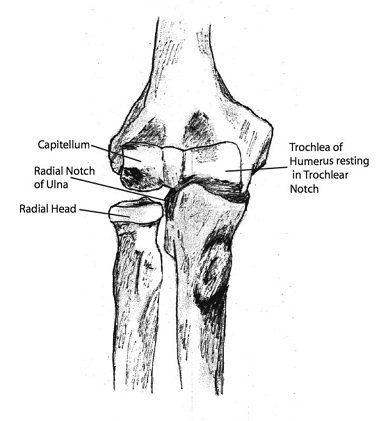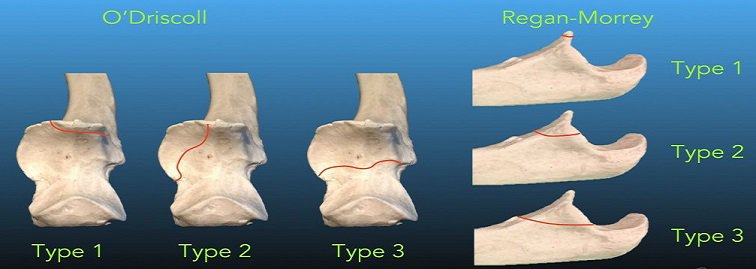Fracture of the coronal process of the ulna
A full range of orthopedic services, from diagnosis to full recovery
Traumatic injuries to the elbow, especially those associated with dislocation, can lead to instability of the elbow, damaging not only bone structures, but also soft tissues.
The coronal process of the ulna is one of the bone structures that can be broken and plays an important role in the stability of the elbow after dislocation.
Coronal fractures are relatively rare injuries, occurring in approximately 2-15% of patients with dislocated forearms. They often occur in an injury called the" terrible elbow triad, " which includes a dislocation of the ulna, a fracture of the head of the radius, and a fracture of the coronal process.
Anatomy of the elbow
The elbow is a joint with rotating and articulated components. It consists of the joints between the humerus, ulna, and radius. The hinge is formed by the condyles of the humerus and the interstitial notch of the proximal ulna, as well as the head of the radius and the head.
The distal part of the humerus has two pits that provide maximum flexion and extension. Rotation occurs between the head of the radius and the radial notch of the ulna, as well as between the head of the radius and the head of the distal humerus.

The coronal process is also a key stabilizer of Varus tension and probably contributes to greater stability during extension than during flexion. There are three soft tissues in the coronal process: the anterior articular capsule of the elbow, the shoulder muscle, and the medial ulnar collateral ligament (MUCL). Collateral ligaments are important elbow stabilizers. MUCL is the main stabilizer against hallux valgus. Isolated hallux valgus instability of the elbow can be found in athletes, such as baseball players, due to a torn or weakened MUCL.
Mechanism of injury
Fractures of the coronal process usually occur due to dislocation of the elbow. Serious injuries, such as road accidents, can also be the cause.
The most common cause of elbow dislocation is a fall on the elbow or outstretched arms from the victim's height or higher. The specific mechanisms of coronal fracture (and elbow dislocation) vary and may include twisting and Flexion, as well as hyperextension.
Coronal fractures were classified into three types within the Regan and Morrie classification system:
O'driscoll offers a more clinically relevant and more widespread classification among orthopedic surgeons:
Fractures of the coronal process can be diagnosed on a simple series of radiographs, usually on a lateral or 45 ° internally inclined projection.
CT is usually necessary to determine the characteristics of a fracture based on the size of the fragment, the degree of involvement of the anterior-medial region, and complex fracture-dislocation. & nbsp; in cases where the diagnosis is not clear after radiographs, CT or MRI is prescribed, with which you can better determine the condition of bone and soft tissues.
in cases where the diagnosis is not clear after radiographs, CT or MRI is prescribed, with which you can better determine the condition of bone and soft tissues.
Treatment
Most elbows that remain unstable after Closed Reduction, or have significant fractures, or serious soft tissue damage, or both - surgical treatment is indicated.
Large fractures of the coronal process can be rigidly fixed, and small or fragmented fractures can be fixed by suturing the bone and anterior capsule to the anterior ulna using sutures or anchor sutures.
Early mobilization is desirable because prolonged immobilization (after 3-4 weeks) leads to almost universally poor results, including persistent contracture, pain, and loss of function. The elbow is protected from Varus and hallux valgus instability by means of articulated fasteners.
Observations and recommendations
Follow - up care is a balance between maintaining stability and restoring movement.
As immobilization continues and the elbow is gradually mobilized, serial radiographs are needed.
Physical therapy plays a central role in restoring mobility. Patients who are slow to regain movement may need either sequential progressive splints or Dynamic splints. Most functional exercises can be performed by bending the elbow from 30 to 130 degrees. If mobility recovery is unsatisfactory, patients may need surgery to correct the contracture.
ENTRUST YOUR HEALTH CARE TO PROFESSIONALS!
The coronal process of the ulna is one of the bone structures that can be broken and plays an important role in the stability of the elbow after dislocation.
Coronal fractures are relatively rare injuries, occurring in approximately 2-15% of patients with dislocated forearms. They often occur in an injury called the" terrible elbow triad, " which includes a dislocation of the ulna, a fracture of the head of the radius, and a fracture of the coronal process.
Anatomy of the elbow
The elbow is a joint with rotating and articulated components. It consists of the joints between the humerus, ulna, and radius. The hinge is formed by the condyles of the humerus and the interstitial notch of the proximal ulna, as well as the head of the radius and the head.
The distal part of the humerus has two pits that provide maximum flexion and extension. Rotation occurs between the head of the radius and the radial notch of the ulna, as well as between the head of the radius and the head of the distal humerus.

The coronal process is also a key stabilizer of Varus tension and probably contributes to greater stability during extension than during flexion. There are three soft tissues in the coronal process: the anterior articular capsule of the elbow, the shoulder muscle, and the medial ulnar collateral ligament (MUCL). Collateral ligaments are important elbow stabilizers. MUCL is the main stabilizer against hallux valgus. Isolated hallux valgus instability of the elbow can be found in athletes, such as baseball players, due to a torn or weakened MUCL.
Mechanism of injury
Fractures of the coronal process usually occur due to dislocation of the elbow. Serious injuries, such as road accidents, can also be the cause.
The most common cause of elbow dislocation is a fall on the elbow or outstretched arms from the victim's height or higher. The specific mechanisms of coronal fracture (and elbow dislocation) vary and may include twisting and Flexion, as well as hyperextension.
Coronal fractures were classified into three types within the Regan and Morrie classification system:
-
< li>type 1: Separation of the tip of the coronal process < / li>
< li>type 2: fragment including & lt; 50% of the coronal process < / li>
< li>type 3: fragment including > 50% of the coronal process< / li>
O'driscoll offers a more clinically relevant and more widespread classification among orthopedic surgeons:
-
< Li > type i: includes the tip of the coronal process and affects approximately one-third< / li>
< Li > type II: anterior-medial side lesion to varying degrees with more medial involvement representing a more severe subtype of injury< / li>
< Li > type III: with a base and with destruction of more than 50% of the coronal process< / li>
Fractures of the coronal process can be diagnosed on a simple series of radiographs, usually on a lateral or 45 ° internally inclined projection.
CT is usually necessary to determine the characteristics of a fracture based on the size of the fragment, the degree of involvement of the anterior-medial region, and complex fracture-dislocation. & nbsp;
 in cases where the diagnosis is not clear after radiographs, CT or MRI is prescribed, with which you can better determine the condition of bone and soft tissues.
in cases where the diagnosis is not clear after radiographs, CT or MRI is prescribed, with which you can better determine the condition of bone and soft tissues.Treatment
Most elbows that remain unstable after Closed Reduction, or have significant fractures, or serious soft tissue damage, or both - surgical treatment is indicated.
Large fractures of the coronal process can be rigidly fixed, and small or fragmented fractures can be fixed by suturing the bone and anterior capsule to the anterior ulna using sutures or anchor sutures.
Early mobilization is desirable because prolonged immobilization (after 3-4 weeks) leads to almost universally poor results, including persistent contracture, pain, and loss of function. The elbow is protected from Varus and hallux valgus instability by means of articulated fasteners.
Observations and recommendations
Follow - up care is a balance between maintaining stability and restoring movement.
As immobilization continues and the elbow is gradually mobilized, serial radiographs are needed.
Physical therapy plays a central role in restoring mobility. Patients who are slow to regain movement may need either sequential progressive splints or Dynamic splints. Most functional exercises can be performed by bending the elbow from 30 to 130 degrees. If mobility recovery is unsatisfactory, patients may need surgery to correct the contracture.
ENTRUST YOUR HEALTH CARE TO PROFESSIONALS!
Product rating is: 8 from 5
Please rate the product:
Advantages of treatment in Orthopedics by Ruslan Sergienko
-
10 years on medical services in Ukraine
-
> 25 years of experience with leading specialists
-
Anna Vovchenko and Ruslan Sergienko are recognized opinion leaders among the orthopedic traumatologists
-
> 150,000 consultations were held
-
> 7,500 surgeries were performed
-
All types of pain management
-
The operating unit is equipped according to international standards
-
Availability of all medicines and supplies
-
Single rooms, equipped with the characteristics of orthopedic patients
-
Three meals a day
-
Postoperative rehabilitation by certified specialists
-
Pricing Transparency
